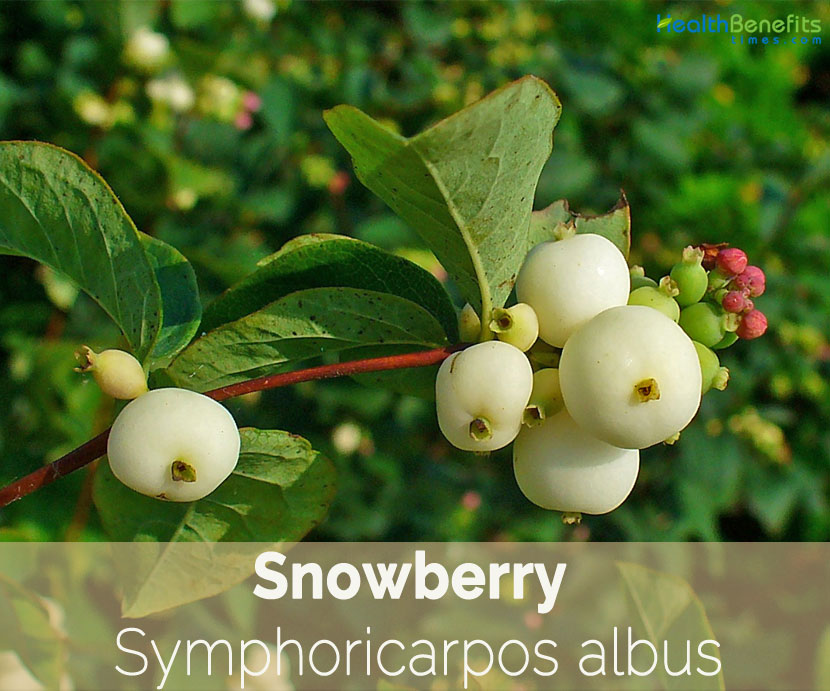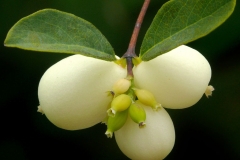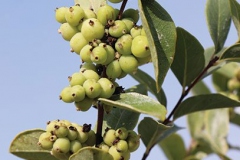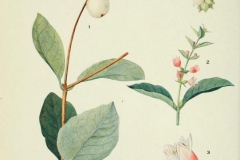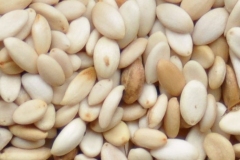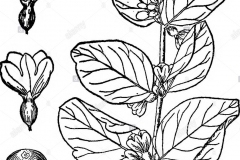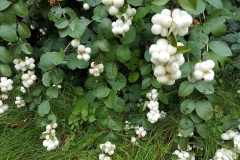| Snowberry Quick Facts | |
|---|---|
| Name: | Snowberry |
| Scientific Name: | Symphoricarpos albus |
| Origin | North America, where it occurs across much of Canada and the northern and western United States |
| Colors | Bright white |
| Shapes | Globoid, fleshy, bright white drupe, about 1/3–2/3 inches (8–16 mm.) across in diameter, with a waxy surface texture |
| Taste | Bitter |
| Health benefits | Beneficial for stomach problems, menstrual disorders, burns, rashes, itches, venereal disease, tuberculosis, fevers, eczema, skin sores and runny eyes |
| Name | Snowberry |
|---|---|
| Scientific Name | Symphoricarpos albus |
| Native | North America, where it occurs across much of Canada and the northern and western United States |
| Common Names | Snowberry, common snowberry, waxberry, thin-leaved snowberry, Northern snowberry, White coralberry, Buckbursh, Waxberry, Ghostberry, Corpseberry |
| Name in Other Languages | Afrikaans: Sneeuwbes, Sneeubessie Albanian: Snowberry, inxhi Amharic: Yeberedo inijorī (የበረዶ እንጆሪ) Arabic: Thaliji (ثلجي), huba althalj al’abyad (حب الثلج الأبيض) Armenian: Dzntsaghik-dzntsaghik (ձնծաղիկ-dzntsaghik) Azerbaijani: Qar ağacı Belarusian: Sniežnajahadnik biely (Снежнаягаднік белы) Bengali: Snowberry-ˈsnōˌberē Bulgarian: Snowberry-ˈsnōˌberē, bulchino tsvete (булчино цвете), byal margarit (бял маргарит) Burmese: Hcatawbhaalre (စတော်ဘယ်ရီ) Catalan: Perler Chinese: Xuě méi (雪莓) Croatian: Snowberry, biserak Czech: Sníh, Imelovník biely, Pámelník bílý, Danish: Snowberry, Almindelig snebær, hvid snebær, snebær, Dutch: Sneeuwbes, druifsneeuwbes English: Snowberry, common snowberry, waxberry, thin-leaved snowberry, Northern snowberry, White coralberry, Buckbursh Esperanto: Neĝo Estonian: Lumehelves, Harilik lumimari Filipino: Snowberry Finnish: Snowberry, Valkolumimarja, Lumimarja French: Snowberry, symphorine blanche, Arbre aux perles, Symphorine à fruits blancs, Symphorine à grappes, Symphorine, Symphorine commune, Symphorine Georgian: Pipkia (ფიფქია) German: Schneebeere, gewöhnliche Schneebeere, Knallerbse, Knallerbsenstrauch, Weiße Schneebeere, traubige Schneebeere Greek: Snóoumpornt (σνόουμπορντ) Gujarati: Snōbērī (સ્નોબેરી) Hausa: Dusar ƙanƙara Hebrew: שלג Hindi: Snowberry-ˈsnōˌberē Hungarian: Snowberry, Keleti bogyóslonc, Közönséges hóbogyó, fehér hóbogyó Icelandic: Snjóber Indonesian: Snowberry Irish: Sú sneachta, póirín sneachta Italian: Snowberry, Lacrime d’Italia Japanese: Sunōberī (スノーベリー) Javanese: Salju salju Kannada: Snōberi (ಸ್ನೋಬೆರಿ) Kazakh: Qarlığan (қарлыған), Aq qarjemis (Ақ қаржеміс) Korean: Seuno beli-seuno beli (스노 베리-seuno beli) Kurdish: Berfê Lao: Hima (ຫິມະ) Latin: Snowberry Latvian: Sniegpārsla, baltā sniegoga, strautu sniegoga Lithuanian: Snieguolė, Baltauogė meškytė Macedonian: Sneg-sneg (снег-sneg) Malagasy: Snowberry Malay: Salji salji Malayalam: Snēābeṟi (സ്നോബെറി) Maltese: Snowberry Marathi: Snoberee (स्नोबेरी) Mongolian: Tsookhor (цоохор) Nepali: Snoberee (स्नोबेरी) Norwegian: Snowberry, Snøbær Oriya: ତୁଷାରପାତ Pashto: د واورې بېړۍ Persian: توت فرنگی, مروارید سفید Polish: Snowberry, Śnieguliczka biała, śnieguliczka białojagodowa Portuguese: Snowberry, Sinforicarpo Punjabi: Sanōbērī (ਸਨੋਬੇਰੀ) Romanian: Snowberry Russian: Snezhnoyagodnik-snezhnoyagodnik (снежноягодник-snezhnoyagodnik), Snezhnoyagodnik belyy (Снежноягодник белый), snezhnoyagodnik rucheynyy (снежноягодник ручейный) Serbian: Snovberri (сновберри) Sindhi: اسنوبري Sinhala: Himaberi (හිමබෙරි) Slovak: Imelovník biely Slovenian: Snežnica, bela Pamela, pokec Spanish: Snowberry, bola de nieve, bolitas de nieve, perlitas Sudanese: Salju Swedish: Snöbär Tajik: ʙarfpūşe (барфпӯше) Tamil: Sṉōperri (ஸ்னோபெர்ரி) Telugu: snowberry-ˈsnōˌberē Thai: Snowberry-ˈsnōˌberē Turkish: Inci çiçeği Ukrainian: Snizhynka (сніжинка) Upper Sorbian: Běły sněženc Urdu: اسنوبیری Uzbek: Karabuak Vietnamese: Dâu tuyết Welsh: Mwyar eira, Llusen eira llus eira Zulu: Iqhwa |
| Plant Growth Habit | Erect, fast-growing densely-branched, deciduous shrub |
| Growing Climates | Banks and flats in canyons, near streams below, thickets, forest edge, and open slopes, from the lowlands to middle elevations in the mountains, Mesic to dry meadows, disturbed areas, grasslands, shrub lands, steppe and montane, riverbanks, thickets, rocky slopes, riparian areas, roadside embankments, railroads, and rocky waste area |
| Soil | Orefers well-drained, heavy soils (clay) and areas that provide enough sun |
| Plant Size | 1–2 m (3.3–6.6 ft) in maximum height |
| Bark | Yellowish-brown bark on young shoots. Bark on older stems and twigs are grayish-brown and scaly or split lengthwise on older shoots |
| Twigs | Slender and yellow-brown |
| Leaf | Leaves are simple, opposite, deciduous, and variable in shape. They are generally oval but can be nearly round (3/4 – 2 1/2” long). The leaf edges vary from entire to shallowly lobed on the same plant and same stem |
| Flowering season | July to September |
| Flower | Each flower has a small, five-toothed calyx of sepals. The bell-shaped, rounded corolla is about 0.5 cm (0.20 in) long and bright pink in color. It has pointed lobes at the mouth and the inside is filled with white hairs |
| Fruit Shape & Size | Globoid, fleshy, bright white drupe, about 1/3–2/3 inches (8–16 mm.) across in diameter, with a waxy surface texture |
| Fruit Color | Bright white |
| Seed | Seeds are hard, flattened, oblong and whitish to light brown |
| Propagation | By seed but it is primarily vegetative, reproducing by sprouting from its spreading rhizome |
| Taste | Bitter soap like flavor |
| Plant Parts Used | Leaves, Stems, Roots, Berries |
| Lifespan | At least 40 years |
| Season | September to November |
| Culkinary Uses |
|
The fruit and shrub itself is high in saponins, which are mildly toxic to humans and pets causing vomiting, but very beneficial for birds, butterflies, and other wildlife. This shrub is used for erosion control in riparian areas, and it is planted in ecological restoration projects on disturbed sites such as abandoned mines. Its white fruits and blue-green foliage made it popular as an ornamental plant planted around old houses of the 1890s through the 1920s like with the Vanhoutte Spirea or Bridalwreath.
Plant Description
Snowberry is an erect, fast-growing densely-branched, deciduous shrub that normally grows about 1–2 m (3.3–6.6 ft.) tall. The plant is found growing in banks and flats in canyons, near streams below, thickets, forest edge, open slopes, lowlands to middle elevations in the mountains, mesic to dry meadows, disturbed areas, grasslands, shrub lands, steppe and montane, riverbanks, rocky slopes, riparian areas, roadside embankments, railroads, and rocky waste area. The plant prefers well-drained, heavy soils (clay) and areas that provide enough sun. It is naturalized in parts of Britain, where it has been planted as an ornamental and a cover for game. The plant produces stiff, branching main stem and often several smaller shoots from a rhizome. It can spread and colonize an area to form a dense thicket. Twigs are slender and yellow-brown. Yellowish-brown bark are found on young shoots while bark on older stems and twigs are grayish-brown and scaly or split lengthwise on older shoots.
Leaves
Pairs of opposite deciduous leave occur along the twigs and young shoots. These leaves are ½ to 1½ inches long, up to 1 inch wide. They are usually oval-elliptic to egg-shaped to nearly round, blunt to round at the tip, mostly rounded at the base, on a short, finely hairy stalk and their margins are usually smooth or slightly undulate (leaves of very young shrubs are sometimes more undulate). The upper surface is hairless to sparsely hairy, dark green to blue-green, while the lower leaf surface is light green to nearly white and hairless. The petioles of the leaves are very short up to ¼ inches in length; light green, and hairless to slightly short-pubescent. New twigs are yellowish to reddish brown, finely hairy when young becoming hairless.
Flower
The inflorescence is a terminal cluster of up to 16 flowers at the ends of new stem growth. The flowers are about 1/4 inch long with a bell shaped pinkish-white corolla. The five corolla lobes have obtuse tips but the lobes do not spread, making the flower appear longer than wide. This is unlike Wolfberry where the lobes spread widely. The green elongated calyx has 5 triangular shape lobes that have a purplish tinge. The inside of the corolla is bearded with white hairs; the reproductive parts have 5 stamens and a style. The inferior ovary is ovoid in shape, but somewhat constricted at the base of the calyx. The light green pedicels of the flowers are very short (less than 1/8 inches or 1–2 mm. long), while other stalks of the inflorescence are light green to reddish purple. The blooming period typically occurs from early to mid-summer for about 1½ months, although it may become extended into autumn under favorable conditions. Flowers have an unpleasant odor.
Fruit
Fertile flowers produce a globoid, fleshy, bright white drupe, about 1/3–2/3 inches (8–16 mm.) across in diameter, with a waxy surface texture. Like the flowers, these will be in a small cluster, which will last into the winter as birds do not usually eat them in the autumn. Each drupe has a waxy-fleshy interior with a bitter flavor and a pair of seeds or sometimes 3. Spongy berries when squeezed have 4-5 mm. long, bony white, flattened, broadly ellipsoid seeds surrounded by a pulpy flesh. The fruit ripens from September to November. With proper storage, seeds are viable for 7 to 10 years. The plant sometimes reproduces via seed but it is primarily vegetative, reproducing by sprouting from its spreading rhizome. Birds disperse the seeds after they eat the fruit. They are non-edible to humans and toxic due to the saponin they contain.
Traditional uses and benefits of Snowberry
- Snowberry was commonly used medicinally by several native North American Indian tribes who valued it especially for the saponins it contains.
- The Native Americans used it to treat a variety of complaints but especially as an external wash on the skin.
- Any internal use of this plant should be carried out with care, and preferably under the supervision of a qualified practitioner.
- Whole plant is disinfectant, diuretic, febrifuge and laxative.
- An infusion of the stems has been drunk to treat stomach problems and menstrual disorders.
- Decoction of the leaves has been used in the treatment of colds.
- Poultice of the chewed leaves has been applied, or an infusion of the leaves has been used as a wash, in the treatment of external injuries.
- A weak solution of the stems and leaves has been used as a wash for children whilst a stronger solution is applied to sores.
- The fruit has been eaten, or used as an infusion, in the treatment of diarrhea.
- An infusion of the fruit has been used as an eye wash for sore eyes.
- Berries have been rubbed on the skin as a treatment for burns, rashes, itches and sores.
- The berries have also been rubbed on warts in order to get rid of them – this treatment needs to be carried out at least three times a day for a period of a few weeks.
- Poultice of the crushed leaves, fruit and bark has been used in the treatment of burns, sores, and cuts, chapped and injured skin.
- An infusion of the roots has been used in the treatment of fevers (including childhood fevers), stomach aches and colds.
- Decoction of the root bark has been used in the treatment of venereal disease and to restore the flow of urine.
- An infusion of the root has been used as eyewash for sore eyes.
- An infusion of the whole plant has been drunk and also applied externally in the treatment of skin rashes.
- Decoction of the roots and stems has been used in the treatment of the inability to urinate, venereal disease, tuberculosis and the fevers associated with teething sickness.
- Poultice of plant parts including leaves, fruit and bark are used to treat burns, sores, cuts, chapped and injured skin.
- An infusion of stem of the plant is used to treat stomach problems and menstrual disorders.
- Decoction of leaves of snowberry is used in treating Cold.
- For External Injuries, a poultice of chewed leaves is applied topically or an infusion of leaves is used as wash.
- Solution of Snowberry stems and leaves is used as a wash for Children.
- Strong solution is applied topically to treat Sores.
- An infusion of plant root is used to treat fever, stomach ache and colds.
- Decoction of root bark is used in the treatment of Venereal Diseases.
- Decoction of root and stem of the plant is used in the treatment of Dysuria (Inability to urinate), Venereal Disease, Tuberculosis and Fever associated with Tooth sickness.
- Berries are rubbed on the Skin to treat burns, rashes, itches, warts and sores.
- Fruits and leaves mashed and applied to cuts or skin sores as a poultice and to soothe sore, runny eyes.
- Tea from the bark was used as a remedy for tuberculosis and sexually transmitted diseases.
- Brew made from the entire plant was used as a physic tonic.
- Fruit of common snowberry has caused vomiting, diarrhea, dizziness, and in severe cases, unconsciousness in humans.
- Tea made from the stem and root of the plant was used to treat fevers and stomach disorders.
- Poultice of the chewed leaves, or a wash made from the leaves, was applied to external injuries to help them heal and prevent infection.
- Berries have been rubbed on the skin to treat rashes, burns, itching, warts, and sores.
- Tea made from the root has been used to cleanse the womb after giving birth.
- The berries and bark combined have been used in a salve, applied daily to treat paralysis caused by nerve damage from stroke.
- Salve can also be used to treat burns, eczema, and cuts and bruises.
- Infusion made of snowberries can be used in treatment of sore, watery eyes. Fresh snowberries can soothe burns, rash and sores on the skin.
Other Facts
- Plants have extensive root systems and are used to stabilize soils on banks and slopes.
- Branches can be tied together and used as a broom.
- Berries contain saponins and have been used as a hair wash.
- Mild decoction of the wood has been used as a cleansing wash for babies.
- Crushed berries have been rubbed into the armpits as an antiperspirant.
- It can be grown as a medium to tall hedge.
- This shrub is an important food source for a number of animals, including bighorn sheep, white-tailed deer, and grizzly bears.
- Native Americans used the plant as a medicine and soap, and sometimes for food, and the wood was good for arrow shafts.
- In Russia, the berries are crushed in the hands and rubbed about for a soothing folk-remedy hand lotion.
- This shrub is used for erosion control in riparian areas, and it is planted in ecological restoration projects on disturbed sites such as abandoned mines.
- Its white fruits and blue-green foliage made it popular as an ornamental plant planted around old houses.
- Wood used to construct cradle boards.
- Stems sharpened and used as root digging sticks.
- Hollow stems used for pipe stems and for arrow shafts for small bird hunting.
Precautions
- The fruit and shrub itself are poisonous to humans.
- Snowberry can be a gastrointestinal irritant capable of causing vomiting, bloody urine, and delirium.
- For humans, the berries are bitter and mildly emetic, and will cause vomiting, dizziness and/or sedation when eaten in large quantities.
References:
https://www.itis.gov/servlet/SingleRpt/SingleRpt?search_topic=TSN&search_value=35332#null
https://npgsweb.ars-grin.gov/gringlobal/taxon/taxonomydetail?id=36006
https://pfaf.org/user/Plant.aspx?LatinName=Symphoricarpos+albus
http://www.missouribotanicalgarden.org/PlantFinder/PlantFinderDetails.aspx?kempercode=e292
https://gd.eppo.int/taxon/SYPAL
http://www.theplantlist.org/tpl1.1/record/kew-2486129
https://en.wikipedia.org/wiki/Symphoricarpos_albus
https://plants.usda.gov/core/profile?symbol=syal
http://www.narc.gov.jo/gringlobal/taxonomydetail.aspx?id=36006
https://www.friendsofthewildflowergarden.org/pages/plants/snowberry.html
https://www.cabi.org/isc/datasheet/523590


